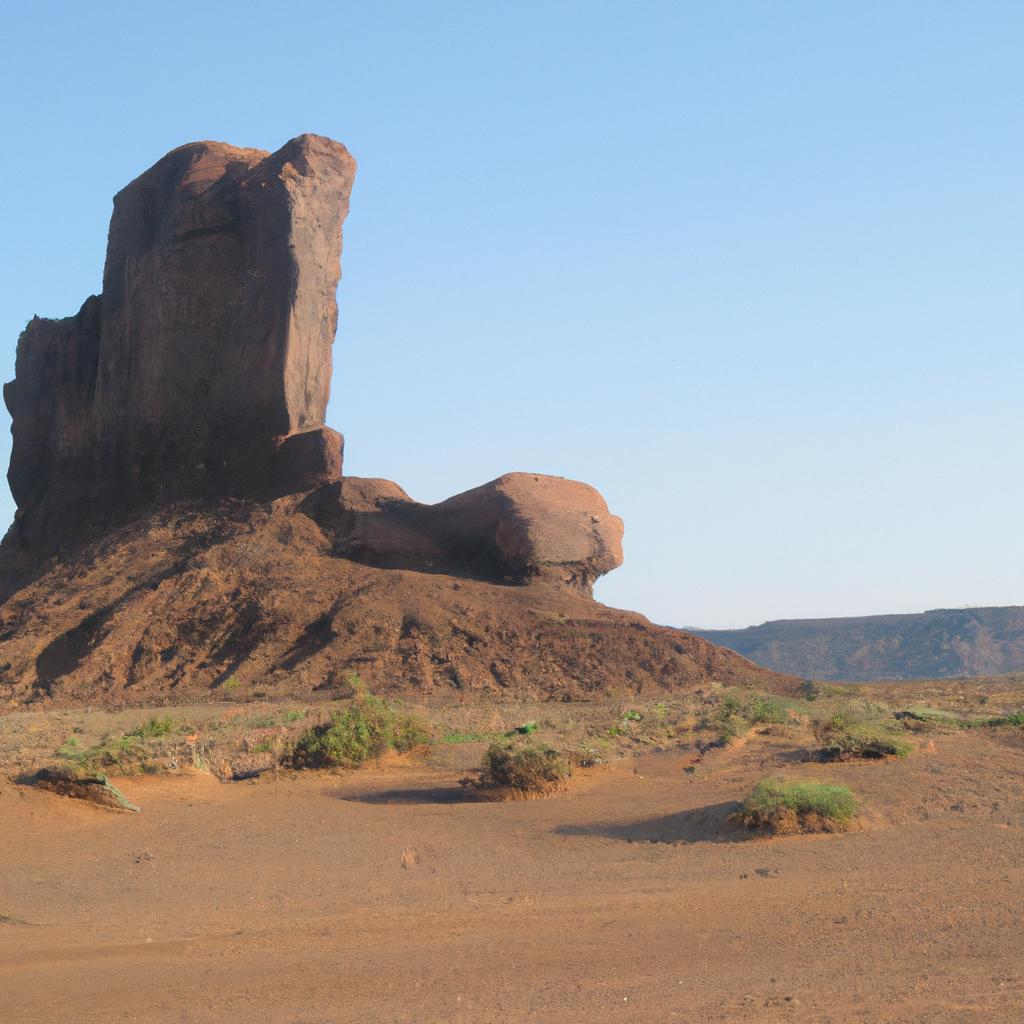When we think of rocks, we often envision ordinary objects that we encounter every day. However, there are certain rocks that hold immense cultural and historical significance. These rocks are known as sacred rocks, and they are revered as divine objects in numerous parts of the world. In this article, we will delve into the importance and significance of sacred rocks, exploring their rich history and cultural relevance.
Definition and Characteristics of Sacred Rock
A sacred rock is a natural or man-made object that is considered holy or divine by a particular culture or religion. It can take the form of a large boulder, a rock formation, a carved stone, or even a meteorite fragment. The types of sacred rocks vary across different cultures. Some cultures revere rocks for their shape, size, or texture, while others associate them with specific religious or mythological events.
The Cultural and Religious Beliefs Surrounding Sacred Rock
Sacred rocks are characterized by their cultural and religious significance. They often embody stories, legends, and myths that are passed down through generations. The cultural and religious beliefs surrounding sacred rocks differ from one culture to another. Native American cultures, for instance, associate sacred rocks with healing and spirituality. In Hinduism, sacred rocks are believed to possess divine energy and are worshipped as deities.
Examples of Sacred Rocks in Different Cultures
The significance of sacred rocks varies depending on the culture and religion. In the Western world, the iconic Stonehenge stands out as a prime example of a sacred rock. This prehistoric monument in England, built around 2500 BC, served religious and ceremonial purposes. In South America, the Inca civilization revered a sacred rock called the Intihuatana, believed to be a source of spiritual energy. Hinduism also embraces the sacred rock known as the Shiva Linga, symbolizing the deity Shiva and worshipped as a manifestation of divine power.
In conclusion, sacred rocks transcend their ordinary nature, embodying a cultural and historical heritage that provides valuable insights into the beliefs and traditions of past civilizations.
Sacred Rock in Ancient Civilizations
Ancient civilizations such as Egypt, Greece, and Rome regarded sacred rocks as symbols of divinity and power. These rocks played crucial roles in religious and spiritual practices and were believed to possess supernatural abilities. For instance, the Egyptians attributed the power of the sun god Ra to the obelisks—tall, slender, four-sided monuments.
Greece boasts the sacred rock known as the Acropolis, upon which the Parthenon temple in Athens was built. The Acropolis served as a place of worship for the goddess Athena, the patron deity of Athens. Constructed in the 5th century BC, the Parthenon stands as an architectural masterpiece, showcasing the skills and craftsmanship of ancient Greeks.
Similarly, the Romans, too, revered sacred rocks. The Pantheon, one of Rome’s most renowned landmarks, stands atop a sacred rock called the Campus Martius. Built in the 1st century AD, the Pantheon was dedicated to the gods of ancient Rome.
The Use of Sacred Rock in Ancient Religious Practices and Ceremonies
Sacred rocks were frequently incorporated into religious rituals and ceremonies in ancient civilizations. In Egypt, obelisks played vital roles in temple rituals, serving as conduits between the gods and the people. Greece utilized the sacred rock of the Acropolis as a site for religious festivals and ceremonies. Similarly, the Campus Martius, a sacred rock in Rome, witnessed religious ceremonies and important public events like the election of consuls and the signing of treaties.
The Significance of Sacred Rock in Ancient Civilizations
Sacred rocks held profound significance in the beliefs and traditions of ancient civilizations. They were believed to possess supernatural powers and were integral to religious rituals and ceremonies. These rocks symbolized divinity and power and served as testaments to the cultural heritage of their respective civilizations. Sacred rocks also played vital roles in preserving history and architecture, showcasing the ingenuity and skills of past civilizations.
Sacred Rock in Native Cultures
Indigenous communities worldwide have revered certain rocks as sacred objects throughout history. These rocks carry immense spiritual and cultural significance and are often utilized in traditional healing practices. In this section, we will explore the role of sacred rocks in Native American cultures and their importance in preserving cultural heritage.
Sacred Rock in Native American Cultures
Native American cultures share a deep connection with nature, holding certain rocks and stones as sacred items. These rocks are often associated with specific spirits or deities and are believed to possess immense power. For instance, the Black Hills of South Dakota hold sacred status among many Native American tribes, being believed to house spiritual energy.
The Role of Sacred Rock in Healing and Spirituality
Sacred rocks play an essential role in traditional Native American healing practices. Healers employ these rocks to create a sacred space that enables communication with spirits and facilitates healing rituals. The arrangement of rocks in specific patterns or configurations fosters a harmonious environment conducive to healing.
The Importance of Sacred Rock in Preserving Cultural Heritage
Sacred rocks constitute a crucial aspect of Native American cultural heritage, warranting preservation for future generations. They provide insights into the spiritual and cultural beliefs of Native American communities, shedding light on their unique traditions and practices. Uniting efforts to safeguard sacred rocks ensures the continued transmission of these essential traditions and beliefs across generations.
In conclusion, sacred rocks hold tremendous spiritual and cultural importance in Native American cultures. They play pivotal roles in traditional healing practices and safeguarding cultural heritage. Preserving these sacred rocks ensures the continuation of Native American traditions and beliefs for future generations.
Conservation and Preservation of Sacred Rock
Preserving sacred rocks stands as a crucial endeavor in safeguarding cultural heritage and history. Despite their significance, sacred rocks face various threats that endanger their existence. In this section, we will discuss these threats and the efforts made to protect and conserve sacred rocks.
Threats to Sacred Rock and Preservation Efforts
Human activity poses one of the most significant threats to sacred rocks. Tourists, drawn to these fragile objects, can inadvertently cause damage. The tourism industry may lead to urbanization that results in the loss of sacred rock sites. Other human activities like mining and construction can also negatively impact sacred rock preservation.
Natural disasters, such as earthquakes, floods, and landslides, can also damage sacred rocks. These disasters erode the rocks, rendering them vulnerable to decay and harm.
Impact of Tourism and Development on Sacred Rock
Tourism and development exert considerable influence on the preservation of sacred rocks. Increased tourism can lead to damages, while infrastructure development may result in the loss of sacred rock sites. Furthermore, construction projects, like roads and buildings, can harm the surrounding environment and indirectly affect the preservation of sacred rocks.
Efforts by Organizations and Communities to Protect and Conserve Sacred Rock
Numerous organizations and communities dedicate themselves to protecting and conserving sacred rocks. Their efforts include establishing protected areas, implementing laws and regulations, and promoting sustainable tourism. Many organizations collaborate closely with local communities to raise awareness about the significance of preserving sacred rocks.
In conclusion, preserving sacred rocks is vital to safeguarding cultural heritage and history. Human activity, natural disasters, and the impact of tourism and development pose substantial threats to sacred rock preservation. Nonetheless, a wide array of organizations and communities tirelessly work towards protecting and conserving these sacred rocks, ensuring their continued importance as a vital part of our cultural heritage.
Conclusion
In conclusion, sacred rocks bear immense cultural, historical, and spiritual significance. They provide glimpses into the beliefs and traditions of our ancestors, enabling us to understand and appreciate our cultural heritage. These rocks exist in different parts of the world and hold unique relevance across diverse cultures, from Native American tribes to ancient civilizations like Egypt and Greece.
Preserving and conserving these sacred rocks becomes our shared responsibility for the sake of future generations. Threats, such as tourism and development, endanger these precious artifacts, emphasizing the need for protective measures. At TooLacks, we recognize the importance of preserving our cultural heritage, with sacred rocks constituting an essential part of it. We hope this article has shed light on the significance and importance of sacred rocks, inspiring you to delve deeper into their intriguing world. Together, let us work towards protecting and preserving these invaluable cultural and historical artifacts.
Citations and Relevant Hyperlinks:



